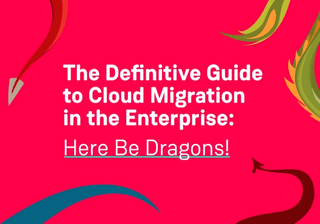Who's Using Amazon Web Services? [2020 Update]
Who's using AWS? Who are the biggest AWS users and what kind of workloads are they using AWS for?
Here's a spoiler: If you're looking at AWS for enterprise-level deployment, you have plenty of company, and if your enterprise is already using AWS, you're in very good company indeed.
(You can also check out who's using Microsoft Azure and who's using Google Cloud Platform!).
What Is Amazon Web Services (AWS)?
Amazon Web Services (AWS) is the world’s leading cloud computing service provider. It has grown to be the most profitable arm of the behemoth that is Amazon, and businesses around the world have grown to know and trust Amazon as their preferred cloud service provider.
Back in 2004, Amazon launched Simple Queue Service (SQS) as the first building block that would become AWS. Two years later in 2006, they released Amazon Simple Storage Service (S3), their seminal cloud service storage solution, and Elastic Compute Cloud (EC2) allowing businesses to build applications fully in the cloud.
Today this list of services has expanded to hundreds of different products. These include services for containers, customer service, storage, identity management, robotics, VR and AR, IoT, databases, and even quantum computing. You’re hard pressed to find a problem that AWS does not have a first-party solution for.
A New Way to Do IT Infrastructure
The uptake of cloud services is growing exponentially. By paying away the undifferentiated heavy lifting in operating IT infrastructure at scale, you can focus your business on what makes you unique and provides business value. The homogenisation of infrastructure also means that tooling constantly evolves to accelerate the speed of technical delivery across your organisation.
As AWS continues to expand, services are built to natively interoperate allowing you to design and build smooth, end-to-end IT solutions for your organisation. And with the continual development and investment into AWS services and offerings, you can rest assured that they will be there to support you with tomorrow’s problems, not just today’s.
Why Choose AWS?
AWS is the best known, and most widely used, cloud services platform on the market. Organisations turn to AWS for their second-to-none product suite, expanding global presence and their sterling reputation for innovation and reliability.
A core AWS principle is “Security is Job Zero”, and true to that they provide all the tools you need to manage your estate, no matter how big you scale. This, coupled with cost management solutions, and offerings which help provide recommendations to secure and optimise your infrastructure, allow you to deliver faster, safer and cheaper than is possible with your on-premise infrastructure, or with other cloud providers.
A Look at AWS Users
According to Amazon, the number of active AWS users exceeds 1,000,000.
While small and mid-size companies make up the majority of that user base, recent polls by private consulting firms suggest that enterprise-scale users make up at least 10% of that total.
AWS Customers: The Ultimate List
Whether it’s technology giants, television networks, banks, food manufacturers or governments, many different organisations are using AWS to develop, deploy and host applications.
Here are the names that are on record publicly as using AWS:
Aon, Adobe, Airbnb, Alcatel-Lucent, AOL, Acquia, AdRoll, AEG, Alert Logic, Autodesk, Bitdefender, BMW, British Gas, Baidu, Bristol-Myers Squibb, Canon, Capital One, Channel 4, Chef, Citrix, Coinbase, Comcast, Coursera, Disney, Docker, Dow Jones, European Space Agency, ESPN, Expedia, Financial Times, FINRA, General Electric, GoSquared, Guardian News & Media, Harvard Medical School, Hearst Corporation, Hitachi, HTC, IMDb, International Centre for Radio Astronomy Research, International Civil Aviation Organization, ITV, iZettle, Johnson & Johnson, JustGiving, JWT, Kaplan, Kellogg’s, Lamborghini, Lonely Planet, Lyft, Made.com, McDonalds, NASA, NASDAQ OMX, National Rail Enquiries, National Trust, Netflix, News International, News UK, Nokia, Nordstrom, Novartis, Pfizer, Philips, Pinterest, Quantas, Reddit, Sage, Samsung, SAP, Schneider Electric, Scribd, Securitas Direct, Siemens, Slack, Sony, SoundCloud, Spotify, Square Enix, Tata Motors, The Weather Company, Twitch, Turner Broadcasting,Ticketmaster, Time Inc., Trainline, Ubisoft, UCAS, Unilever, US Department of State, USDA Food and Nutrition Service, UK Ministry of Justice, Vodafone Italy, WeTransfer, WIX, Xiaomi, Yelp, Zynga and Zillow.
The Big Spenders
Clearly, AWS is the cloud computing platform of choice for businesses across a range of industries. But who are the biggest, and how much money are they spending on these services?
According to Intricately, the top ten AWS users based on EC2 monthly spend are:
- Netflix: $19 million
- Twitch: $15 million
- LinkedIn: $13 million
- Facebook: $11 million
- Turner Broadcasting: $10 million
- BBC: $9 million
- Baidu: $9 million
- ESPN: $8 million
- Adobe: $8 million
- Twitter: $7 million
Putting AWS to Use
Now that you have a better understanding of the different types of AWS customers, you’re probably wondering how they actually use the platform? Here are a few examples:
Netflix Pushes AWS to its Limits
Among enterprises, Netflix was the most prominent early user of AWS, adopting it in 2009.
According to an article in Business Insider from January 2016, Netflix placed enormous demands on the resources available to AWS at the time, often pushing the service to its limits and beyond. The ongoing pressure from Netflix, combined with Amazon's willingness to improve its service and meet its customers' requirements, pushed AWS to develop into the full, enterprise-scale integrated set of services that it is today.
All in: the Big Commitment
By mid-2015, Netflix had gone ‘all-in', closing the last of its major data centres and moving all of its IT operations to AWS. Other enterprises have also gone all-in with AWS, including Intuit, Hertz, and Time, Inc. These companies have demonstrated their willingness to trust AWS with their entire IT operations, including transactions, customer databases, and the rest of the information infrastructure on which they depend. This level of commitment and trust on the part of long-established (and often very conservative) enterprises speaks volumes about the ability of AWS to meet the needs of enterprise-level clients.
According to Amazon, Netflix uses more than 100,000 server instances on AWS for “nearly all its computing and storage needs.'' This includes databases, analytics, recommendation engines and video transcoding.
Speaking about the firm’s use of Amazon Kinesis Streams, Senior Software Engineer John Bennett said it “processes multiple terabytes of log data each day and that “events show up in our analytics in seconds”. He added: “We can discover and respond to issues in real time, ensuring high availability and a great customer experience."
Cloud migration is a big, fat DRAGON of a problem.
In our white paper, we explore the four dragons that are most likely to burn your transformation to the ground and the tools to slay them.
We're sharing our tried-and-tested framework for successful cloud migrations under the difficult, murky, shifting conditions of enterprise IT.
A Few AWS Case Studies
Let's have a closer look at some of AWS's biggest clients:
Unilever
Unilever North America, the U.S. branch of the venerable global-scale manufacturer of food, household, and other consumer products, found that its time-to-market (crucial in the consumer goods industry) was being held back by the lack of standardised technology among its on-premises IT facilities and websites.
Unilever conducted an exhaustive review of the available cloud-based options, and finally chose to migrate to AWS, using a full range of AWS services to support 1,700 digital marketing web properties on a worldwide basis.
For Unilever, the advantages include increased speed of rollout for a website (now two days, rather than the pre-AWS average of two weeks), and the increased speed at which changes to a site or a marketing campaign can be made. Unilever also uses AWS for comprehensive backup and disaster recovery, and for rapid deployment of standardised infrastructure.
GE Oil & Gas
The oil and gas division of General Electric has migrated 350+ applications to AWS, cutting the average cost of ownership by over 50%, according to their own estimate. For GE, the cloud migration process is ongoing, with constant review of on-premises applications and services to see which ones are the best candidates for transfer to the cloud.
The ability to monitor the use of cloud-based applications is important to GE's IT team, since it allows them to accurately gauge expenses and savings, to determine when services should be active (and thus billable), and when they should be turned off.
AWS' capacity for handling large amounts of data is important to GE as well. The oil and gas division needs to be able to process enormous volumes of mission-critical automated pipeline inspection data. It is using AWS technology to store and transport the data, and for data analysis and processing, saving time and improving the quality of the results.
Kellogg’s
The Kellogg Company, or Kellogg’s, a familiar breakfast-table name, is a company with a long history (founded in 1888), with worldwide operations. For Kellogg’s (as is the case throughout the breakfast-cereal industry), product promotions are all-important.
The Kellogg company had been relying on an on-premises database for modelling marketing campaigns and analysing promotion and sales data, but the system, which could run no more than a single simulation per day, was no longer able to keep up with the company's needs.
As a replacement, Kellogg’s chose a SAP promotion planning and simulation application. At the same time, they chose to run the SAP application on AWS, rather than on-premises. The decision to migrate to AWS was motivated by a number of factors, including speed and overall capacity. (The system handles 16 TB of weekly sales data, with several dozen marketing simulations on a weekly basis.) AWS also offered high availability, reduced cost, and flexibility in IT planning. The combination of SAP and AWS (with its support for SAP software) has given Kellogg’s a significant advantage in a very competitive market.
Shell
Like many other large businesses operating on a global scale, energy giant Shell has taken steps to protect itself from the rising threat of cyber attacks. In particular, the Netherlands-headquartered firm decided to look at ways it could improve its security information and event management solution.
To stay ahead of cyber criminals, Shell required the ability to run detailed analysis of trends over time and continually spot vulnerabilities through a cyberthreat hunting function. The challenge? Its SIEM solution just didn’t have the capacity to perform these critical functionalities.
Using around 100 EC2 instances and Splunk Enterprise Security applications, the firm has implemented a much more powerful cyber security solution for analysing real-time and historical data. This means Shell can protect itself from current and emerging cyber threats. According to Shell CyberDefence manager Oskar Brink, the firm is “finding more than twice as many events that could have resulted in security incidents and breaches”.
Expedia
As cloud and mobile technologies continue to dominate the business landscape, lots of firms are moving away from physical data centres in search for more sustainable and efficient alternatives.
Travel comparison website Expedia is an excellent example, having unveiled plans to move 80% of mission-critical applications to the cloud through AWS. The firm decided to do this after discovering that the main reason for people leaving its website was due to error pages. Expedia wanted customers to get around its websites quickly and without running into any issues.
Using a range of AWS solutions, Expedia claims that it has become more resilient, has the ability to develop new applications faster and can save millions in the process. Magesh Chandramouli, Principal Architect, said: “By using AWS, I’m not bound by throughput limitations or CPU capacity. When I think of AWS, freedom is the first word that comes to mind”.
Airbnb
It’s not just long established companies using AWS to run their compute estate. Airbnb, a community rental marketplace for property owners and travellers, lists more than 7 million accommodations and is a long-time user of AWS.
Catering for millions of customers globally, the firm has continued to invest in AWS solutions as it has grown rapidly in the past few years. Currently, it has 200 Amazon Elastic Compute Cloud instances to manage its core application, memcache and search servers; Elastic Load Balancing for handling incoming traffic between these servers; Amazon Elastic MapReduce for processing and disseminating data; Amazon Simple Storage Service for backups and static files; and Amazon CloudWatch.
Since implementing these solutions, Airbnb takes the view that it’s better equipped for future growth and can save money across its operations. Tobi Knaup, an engineer at Airbnb, said: “Because of AWS, there has always been an easy answer (in terms of time required and cost) to scale our site.”
Apple
When it comes to any aspect of its business, Apple is pretty secretive. But according to a 2019 report by CNBC, it happens to be one of the biggest spenders on AWS services. People familiar with the setup told the American broadcaster that the Cupertino-based firm spends over $30 million per month on Amazon cloud computing services.
The iPhone maker hasn’t confirmed these claims, but with growing demand for internet services such as iCloud and Apple Music, it makes sense that the firm would need a comprehensive cloud solution. CNBC points out that Apple has worked with other cloud providers, including Google and Microsoft, in the past.
Did You Know?
By now, you should have a better understanding of who uses AWS and how. However, what else sets AWS apart? Here are some interesting statistics about the cloud platform.
Revenue
Since launching in 2006, AWS has expanded exponentially, with Statistica stating that net sales were $25.5 billion in 2019; a significant growth compared to the $17.5 billion it made a year before.
Users
Of course, AWS wouldn’t be able to achieve such impressive revenues if it weren’t for a growing customer base. AWS claims to serve “millions of customers”, which include “fastest-growing startups, largest enterprise and leading government agencies”. In 2016, ArsTechnica reported that AWS had more than a million users.
Developers are an important demographic for AWS. According to Statistica, 26.6% of software developers used AWS services last year. Meanwhile, 19% of connected devices ran on AWS in 2019.
Services, Regions and Partners
When it comes to the product itself, AWS currently provides “175 featured services from data centres globally”. The firm operates data centres across the US, Canada, France, Germany, Ireland, the UK, India, Japan, Singapore, South Korea, Sweden and Brazil, as well as one exclusive region for the US Government and two regions for Chinese customers. AWS also operates a large partner network, which is comprised of over 8,000 businesses that can help customers implement and build applications on the platform.
Market Share
Clearly, AWS has achieved some big milestones in recent years. But what other statistics should you know? Figures from Statistica show that AWS currently has a market share of 47.8% in the Infrastructure-as-a-Service sector, along with a share of 25.2% in the Platform-as-a-Service arena.
Contino's 2020 research report The State of the Public Cloud in the Enterprise shows that a whopping 64% of enterprises (who are in the cloud in some capacity) use AWS.
The AWS Opportunity
For many different organisations, the use of AWS is evidently widespread. But it’s not just interesting to see companies of varying industries implementing Amazon’s cloud tools.
They’re also using it for different use cases, whether it’s mitigating cyber security threats or developing faster websites. The opportunity here is huge. What great things will you achieve with AWS?


![[Infographic] Cloud Migration in the Enterprise: Here Be Dragons!](https://cdn.sanity.io/images/hgftikht/production/650b295b773a444805642575d25df90c7c39296a-1200x624.jpg?w=158&h=107&fit=crop)
![9 Game-Changing DevOps and Cloud Trends [2020]](https://cdn.sanity.io/images/hgftikht/production/0eb3e8126ec5f7ec8892bf09e7c36b937aa06f3c-1200x511.png?w=158&h=107&fit=crop)

